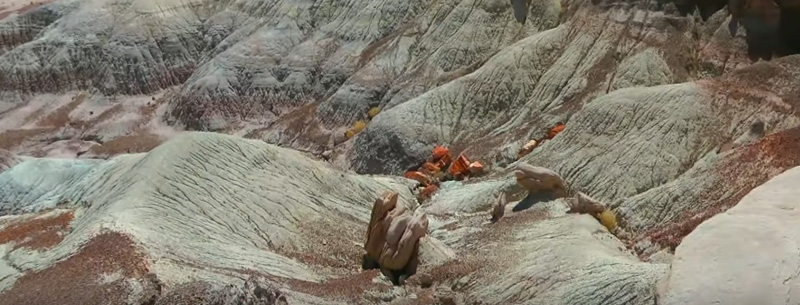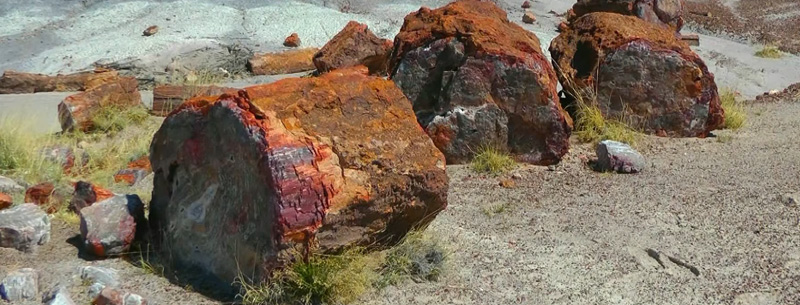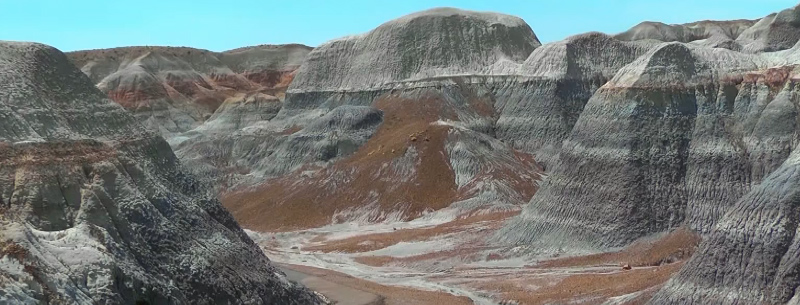2 Arizona National Parks Combined
Visit one, you should visit the other. The Petrified Forest and Painted Desert merge together. The Petrified Forest National Park includes the Painted Desert to the north and the Rainbow Forest to the south. Travel back into prehistoric times to the Triassic Period over 200 million years ago when lush forests once stood on this now dry, barren land and dinosaurs once roamed. In more recent times, yet still just thousands of years ago, ancient peoples called this area home.
It’s difficult to imagine this land was once a thick forest of conifers and at some point in time, the area was covered heavily with the ocean. Today it is dry and barren land that is rich with amazing archaeological and geological discovery. Fossils are clues to the past millions of years and tell many stories of ancient ecosystems. Fossils dating back to the Late Triassic Period have been discovered and are on display. As a point of reference of time, the Late Triassic Period is called the “Dawn of the Dinosaurs” and preceded the Jurassic Period when dinosaurs ruled the earth.

The Painted Desert and Petrified Forest. Located 115 miles east of Flagstaff AZ near Holbrook, Arizona. The North entrance to the park is located off Interstate 40 and the South Entrance is off Highway 180. Tourists may enter and exit at either entrance location. There are Holbrook Hotels about 20 miles away with a much larger selection of hotels in Flagstaff.
Painted Desert
Spans over 160 miles. Although the main entrance is 115 miles East of Flagstaff, the Western edges of the Painted Desert can be seen near Cameron, north of Flagstaff off Highway 89 on the Navajo Indian Reservation near the Grand Canyon. It gets its name from the myriad of colors created by geological transformation. The park features its Painted Desert Visitor Center just off Interstate 40. It houses thousands of artifacts and prehistoric specimens and rangers that will gladly answer your questions. There are a number of short, easy hiking trails, but the non-adventurous, drive along the 10-mile paved road inside the park.
Petrified Forest
Forests of conifer trees once thrived. Millions upon millions of years ago an abundance of water created lush forests of conifer trees. Volcanic eruptions toppled trees that were swept away by flowing water and deposited in marshes. Over millions of years, these trees were gradually covered with volcanic ash and mud and were buried deeper and deeper with sediment. During a very slow process of “petrification”, logs transformed to colorful entombed stone.

Ocean eventually covered the area bringing even more sediment. Over 60 million years ago, the ocean totally receded, replaced by flowing rivers which slowly etched away about 2,600 feet of sediment exposing beautiful crystal petrified logs that we see today. A chemical process of released by decomposition reacted with wood to create quartz crystals that “cocooned” the decomposed trees slowly turning them to stone. Quartz is colorless but the water-produced minerals that gave the quartz colorful hues.
Ancient civilizations
Long after trees were petrified, dinosaurs became extinct and these once lushly greens lands turned to arid desert, ancient American Indians moved into the area beginning about 10,000 years with the Anasazi Indians followed by the Hohokam. The Sinagua Indians who are believed to be the ancestors of today’s Hopi and Navajo Indian Tribes arrived in the area about 1,000 years ago.
More than 650 ancient Indian sites have been discovered in the park ranging from just one-room shelters to a 100-room pueblo near the Puerco River. When the Spanish began their explorations of the Southwest in 1540, they did not find permanent residents within the Petrified Forest. However, roving bands of Zuni, Hopi, and Navajo people did roam through the area. Ruins of a small group of Navajo hogans also shows that some of the Navajo may at one time have lived in what is now the park. The area holds the largest known concentration of solar calendars. Rock art and petroglyphs exist throughout both parks.
Directions
Take Interstate 40 East from Flagstaff, Arizona for about 115 miles. The exit to the Petrified Forest and Painted Desert is about 15 miles east of Holbrook, Arizona. Actually, the main body of the Petrified Forest lies between I40 to the south and Highway 180 to the south. Entrance and exits to the park can be from either the north or south side. The inland drive into the Painted Desert is north of I40.
Painted Desert and Petrified Forest National Park. For entrance fees and schedules, call 928-524-6228 or visit its website.
